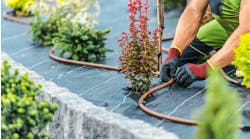Kane County, Ill. — Sixty miles northwest of Chicago, a green building team, consisting of more than 25 members, including trade contractors, consultants, technology vendors and other building professionals, is utilizing sustainable products and systems to build custom homes here at Serosun Farms, a 410-acre agricultural preservation community, featuring a community center, organic farm, equestrian center, eight miles of recreational trails and restored prairie land.
The residential development was initiated by the developer of Serosun Farms, John DeWald of John DeWald & Associates, a real estate investment consortium, Encinitas, Calif., several years after his sister bought the property, including two farms, in Kane County to develop a horse farm.
According to DeWald, it didn't take her long to realize that Chicago suburbs were sprawling further northwest — she didn't want her property to be near traditional suburban housing developments.
“The options were to move further west or do something to preserve the farm, but we needed to create a development to help fund it,” said DeWald. “The idea for the development of a conservation and farm preservation project started there, and we found that sustainability was a reoccurring theme that we were interested in, so we adopted that approach into a lot of different components of the development, whether it's residential home development or the equestrian area of the farm.”
The homes will range from smaller country cottages to mid-sized farm homes and larger country estates, ranging from a minimum of 2,000-sq.ft. to a maximum of 6,000-sq.ft., and meet the requirements of the National Association of Home Builders Green Build, U.S. Green Building Council's LEED, EPA Energy Star and American Lung Association Healthy Home programs. The homes will also need to meet the community's own building standards.
According to DeWald, the custom built homes are expected to use 80-90% less energy and 50% less water than traditional homes by utilizing geothermal, solar and water harvesting systems, among other sustainable techniques and products.
“We are trying to keep the goals of a smaller energy footprint than a traditional house, and a smaller footprint in water requires certain technologies in the home,” said DeWald. “When you incorporate sustainability into every facet of the home and its community, homes will basically run themselves.“
Sustainable systems
The community has organized its building, design and operating approach around energy and water conservation, environmental quality and resource conservation.
The energy conservation systems include passive design techniques and integration and use of renewable energy sources. A small scale wind turbine, geothermal heating and air conditioning system, and photovoltaic system will be installed during the first two phases of the development.
A photovoltaic system will be installed on the roof of the model home and on all future homes. Calculations will need to be done on each home to find out the exact amount of solar panels needed since all homes will be custom.
According to DeWald, the designs need to allow for enough space on roof areas, facing generally south and, with the newer roof-integrated PV panels, there is not as much concern with solar being on the front of a home and showing.
“We need to figure out how much solar we can put on each house to drive the electrical supply in each house, said Scott Skiermanski of Stoneridge Builders Inc., the partnering master builder at the community. “All things that we incorporate will help us reach that 80%-90%, so we hit that percentage.”
Spring Grove Heating & A/C, Spring Grove, Ill., a partner with ClimateMaster, will install the geothermal system, which will heat the model house and a portion of the domestic water. ClimateMaster heat pumps will be operated by the electricity from the photovoltaic system.
The water conservation systems will reduce the amount of water consumed by the home and its inhabitants by using low-flow fixtures, efficient irrigation systems, graywater systems and a rain harvesting system, which will store 1,000-gal. of water in an underground tank. The water from the rain harvesting system will be used for irrigating the native landscape, and for potable systems, thus lowering water consumption. A storm water and water quality management system will also be utilized to conserve as much water as possible, and a variety of low-flow Kohler products will be installed in the homes.
“Many of the Kohler products, showerheads, toilets, etc., have been engineered so a large portion of product inventory can be used with the right diverters to create water conservation ability,” said Skiermanski. “There is value engineering that is part of the process and green guidelines that will reduce water and produce a better quality home in the end.”
A horizontal wind turbine on the property will create energy to operate the farm and horse center. The turbine will be installed during the first and second phase of the development plan.
According to DeWald, horizontal turbines are not as tall as a typical wind turbine, and this style of turbine was picked because wind lower to the ground can be used effectively. During later phases of the project, using larger wind systems will be considered, so the houses and estates can share energy.
“There are additional things we can learn about in phase one and two, then apply those more broadly in the future phases,” said DeWald.
The green team
DeWald and Skiermanski both agree that building sustainably is most successful when an integrated team designs and builds a home. The green building team at Serosun Farms is managed through a central program, providing that all houses built on the property will use sustainable products and technology.
According to DeWald, the green building team was created to ensure all custom homes meet a specific level of sustainability, utilizing high-performance sustainable products and technologies.
Stoneridge Builders Inc. is responsible for coordinating the green building team. Other master builders will be selected for the project based on their ability to work effectively with the green building team.
“We are finding that you need the architect, builder, subcontractors, as well as the products and technology groups to all work together,” explained DeWald. “We need to be cost effective and help our buyers find and build that team — to choose what is most appropriate for the development — we sign up vendors and contractors that we feel are best suited for the project.“
A Builder's Council at Serosun Farms will review all new builders seeking to be a part of the green building team to ensure they are qualified to build high-performance homes. Serosun Farms also provides guidance by outlining the minimum requirements through residential design guidelines, monitored by a Design Review Committee and consultant. All home plans will be reviewed by the committee and consultant, so any issues or opportunities can be identified, ensuring homes are built according to plan and all the elements are working.
According to DeWald, the green building team is not only focused on building sustainable homes, they also want to build cost effective homes.
“We are not just throwing a bunch of costs at potential buyers; we are looking at cost effectively building high-performance homes,” said DeWald. “They will be much more efficient to operate and maintain.”

